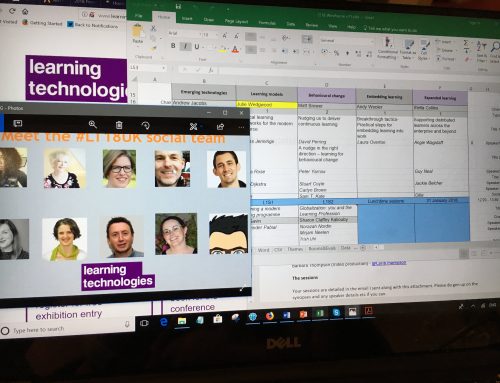This week I attended the annual Learning Live event in London. Here are my key takeaways from an engaging, thought-provoking event.
Jane Bozarth on showing your work
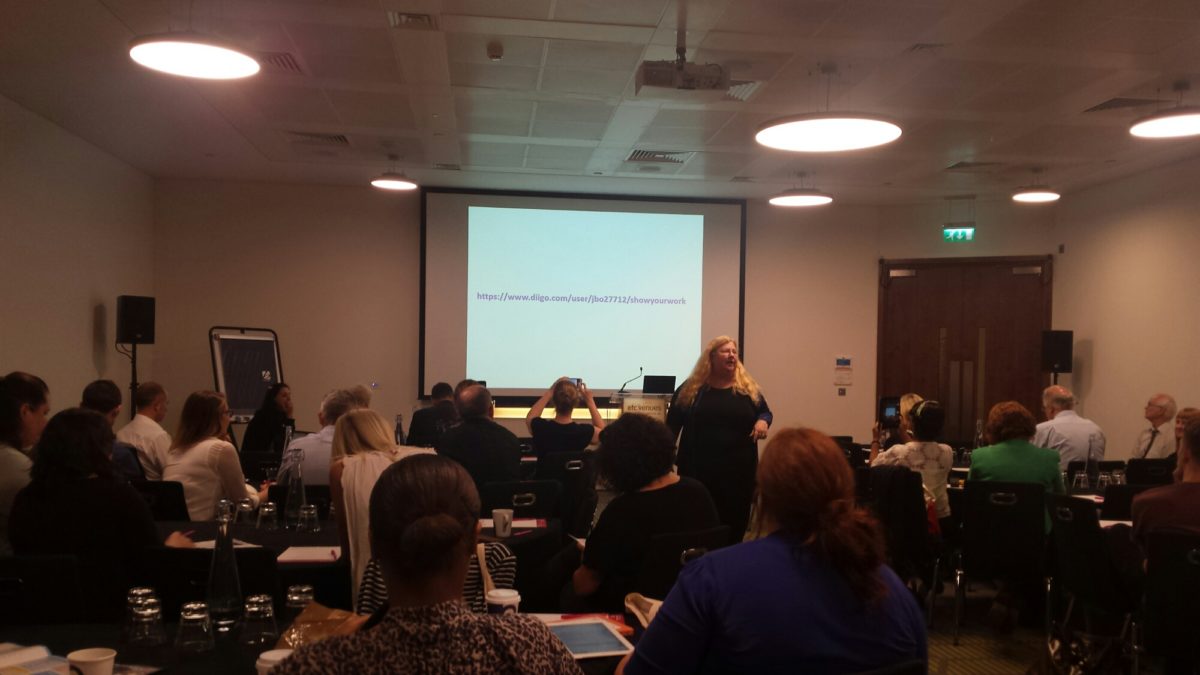
This session proved challenging for many in the room. Jane is a fantastically engaging speaker. She also thoughtfully set up a link to curate all her resources around this session hier. But she’s pushing boundaries and challenging the status quo – and that can be hard for people to get their head around. I think there’s general consensus that showing your work/working out loud is deemed to be a positive step. BUT there are some buts for many (not for me personally, this is what I took away from the discussion in the room and some of the tweets. Hone in on the session tweets hier).
- It’s hard for organisations to move away from writing everything down. Jane’s point about organisations needing to get better at sharing tacit knowledge is so important. But as illustrated by a simple exercise in which we wrote down the steps involved in making a peanut butter and jam sandwich (our group had 14 steps!) we aren’t actually very good at translating that knowledge into the written word. Organisations are full of guides and manuals that poorly convey knowledge. But writing them seems sort of ingrained in us. Making YouTube style help videos could be a much better solution – but shaking off the shackles of the past and stopping the knee jerk reaction to write everything up will take time I think.
- Self-censorship is required. If you’re showing your work – pretty much nobody is going to want to see EVERYTHING that you’re doing! There is a skill in filtering what to share because…
- Noise is a potential issue. If everyone in an organisation suddenly starts showing their work/working out loud, how do you zoom in on the most relevant or interesting bits for you? Andrew Jacobs said (and I paraphrase) one person’s noise could be another person’s signal. So filtering what you consume as well as what you share becomes an essential skill
- It’s scary. Lots of people are fearful of showing their work. Many of us have a natural instinct to get things polished before sharing them. Showing a raw work in progress can be quite intimidating. I think some people are constrained by their own fears of not wanting others to think they are incompetent. Others will be constrained by their organisational culture. Jane quite rightly said that it needs to be OK to fail. But the acceptance around that will vary hugely from organisation to organisation.
I am personally trying to work out loud a lot more. It’s something we do here at Fosway and I am finding it hugely beneficial. I have started to let go of that instinct to hone and polish before sharing a piece of writing for example. Because actually the earlier I get feedback and input on it, the better the end result tends to be. I think we’re going to see the trend of showing your work grow but we need more Janes to show us the way.
Elliot is a such an engaging character. He didn’t push too many boundaries but equally he didn’t espouse theories either, his pretty practical musings went down well with the audience. He talked about ritual being the biggest obstacle for L&D and how we need to start thinking about things differently. If L&D was rewarded for performance of new starters for example, how long they stayed, how long they took to get to a decent competency level – Masie posits that the induction training process would change pretty quickly! Out would go the introductory videos from the CEO and the learning would be far more focused on their actual job. But instead he said:
I can’t argue with that! I think we know we need to move beyond this type of evaluation to actually measuring the impact and performance results of what learning does. But it never hurts to be reminded of it!
Joe Tidman – Delivering an agile global learning strategy
Joe works for GlaxoSmithKline and the scale of his task in learning is just mind blowing. 100,000 people across 150 countries in an organisation that turns over more than £20 billion. Two years ago, there were hundreds of staff not really knowing what they were doing, millions of pounds being spent on nobody really knew what – an incredibly fragmented learning landscape. Not uncommon in this type of organisation, but what Joe and his team have done is wrestle back control of that. They started by focusing on three core pillars. Joe believes that real change wouldn’t have happened if they had just focused on one element – all the change needed to happen simultaneously and work together. They focused on organisational alignment, creating a global curriculum and a global capability model (there were previously over 40 models company wide) Having these pillars in place is enabling them to streamline and become more agile in implementing learning initiatives.
They did shed some L&D staff along the way, but now their global learning organisation is split across learning operations (the biggest pool), embedded business partners and a small centre of excellence. They’ve also gone through tech changes (interestingly Joe imposed a blackout of old systems and content so when he introduced new ones, people couldn’t revert back to the old stuff), introduced a new approach to learning that doesn’t always involve a F2F course (80:10:10 as opposed to 70:20:10) and have had to deal with handling huge cultural shifts:
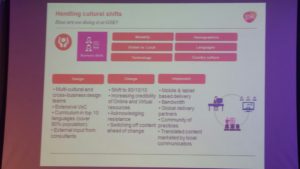
They’ve achieved an awful lot but there is more to do. The bugbear Joe still hears is that there’s so much content, people can’t easily find what they need when they need it. So they’re working on surfacing resources and creating more personalised journeys for people. This was a really honest and informative session. For me, the key takeaways are: there are numerous benefits in unifying fragmented learning operations across an organisation, that a tech blackout is a useful tool when introducing new systems (a great idea to support a new system launch) and that to personalise we must first standardise. Joe had to make sense of what they had, streamline it and apply it in a standard way to sort learning out *before* he could start looking at personalising people’s learning journeys. And I think that’s potentially valuable advice for anyone in a similar situation.
Wiseman blew Learning Live away. From the moment he came on stage doing a magic trick (yes really), the audience were in the palm of his hand. Engaged and often crying with laughter, Wiseman applied humour to relax us and put us into an open mindset. So when he later talked about the nature of good luck and bad luck (more on his work hier) we were all very open to what he was talking about. Much like Dweck’s work on mindset, his psychological studies have revealed that much of what makes us lucky is down to our approach to life. And if you have a growth mindset you are probably likely to be ‘lucky’ as you will see opportunities as they arise. Wiseman encouraged us to try doing things differently, echoing Masie’s earlier sentiment that ritual can be a bit of a killer. Which was summed up by this fantastic clip of an American Football play that goes a little ouside the box…there’s something for us all to learn from this in expanding our horizons and doing things a little differently.
Julian Stodd – The socially dynamic organisation
Stodd introduced this as a working out loud session where he is applying some of his new research and thinking.
I’m familiar with Julian’s view that organisational structures and cultures need to move beyond their Victorian origins of command and control. But this can’t happen without a huge impact on the social contract between an organisation and its people. No longer should people be viewed as merely assets or resources. And Julian’s new research is exploring the dynamics that exist around issues like people’s trust in an organisation or how they feel valued. This links back to employee engagement for me. And it is going to be a huge problem for organisations if their people don’t trust them and don’t feel valued (which is about more than just money by the way, although financial rewards top the list) they won’t be able to retain or develop talent. And they will fail. The social age is one of flux it seems and I am intrigued to see how much the organisational model can really evolve. It is going to be slow with many falling by the wayside I fear. Whatever we do in L&D will happen against this backdrop and I really think learning is well placed to be a driver in all this change rather than a laggard responding to these changes after the fact.All very high level but fascinating nonetheless. I am looking forward to getting my head more around Julian’s thinking with the second edition of his book which I picked up after the session.
Sarah Lindsell – Getting practical
The last session of the day can sometimes feel like a chore at events. But getting insights from PwC’s Global Director of Digital Learning and Transformation was a privilege. Sarah talked about how she runs her (huge) L&D remit across 142 territories as a business within the business. And this puts her in a mindset that is all about being proactive and performance oriented. She is ‘not about bums on seats or completion rates’ and to demonstrate this, she produces a value report at the end of every financial year. This details the global L&D spend and the impact it’s had. A great tip to highlight to the rest of the organisation where you’ve added value over the past year. This mindset also means Sarah leads from the front by representing her ‘business’ and that means being able to sell and market what L&D is doing. And building key relationships to help it function effectively e.g. making friends with the people you need like IT and procurement (echoing Joe Tidman’s advice earlier in the day).
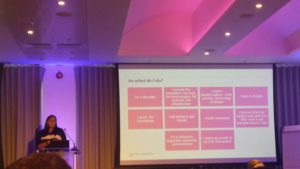
Sarah also shared her model for innovation: watch, play, jump, fly. I like the honesty that sometimes trying new things is a bit of a leap of faith. And to help her innovate she schedules a ‘getting lost day’ once a month where she catches up on new research or plays with new tech. Setting aside time to do this is such a good idea as it’s so easy to get caught up in the day-to-day work that it’s easy to lose that opportunity to see what’s going on elsewhere. The other catchphrase Sarah has is ‘know enough to be dangerous’. So if you’re implementing a new platform, take the training and know how it works – that way you’re eating your own food before serving it someone else, but you also have enough understanding of your new tech to question it (or what people are doing with it). And I think once you get to the top of any profession, that level of detailed insight can get lost. You don’t need to know it inside out but being able to interrogate what’s going on is excellent advice.
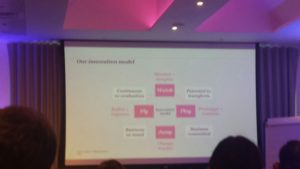
See more of what happened via the hashtag for the event, #LearningLive. And thanks again to the LPI team for having me along.



